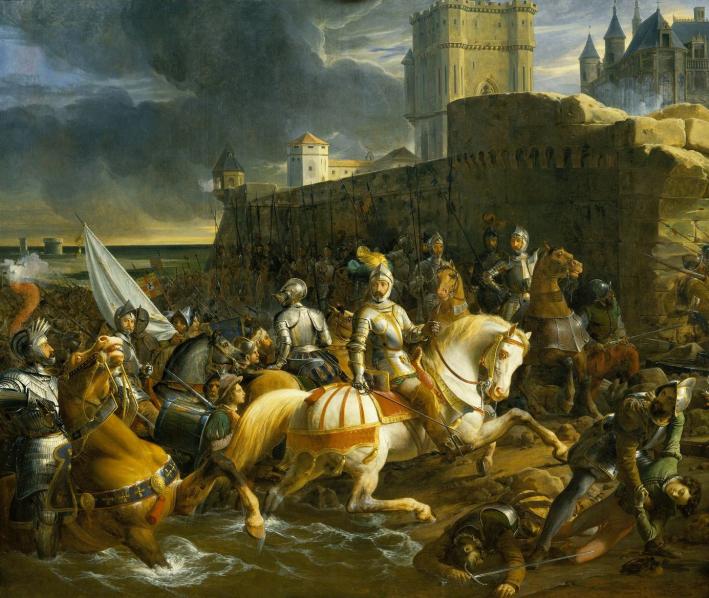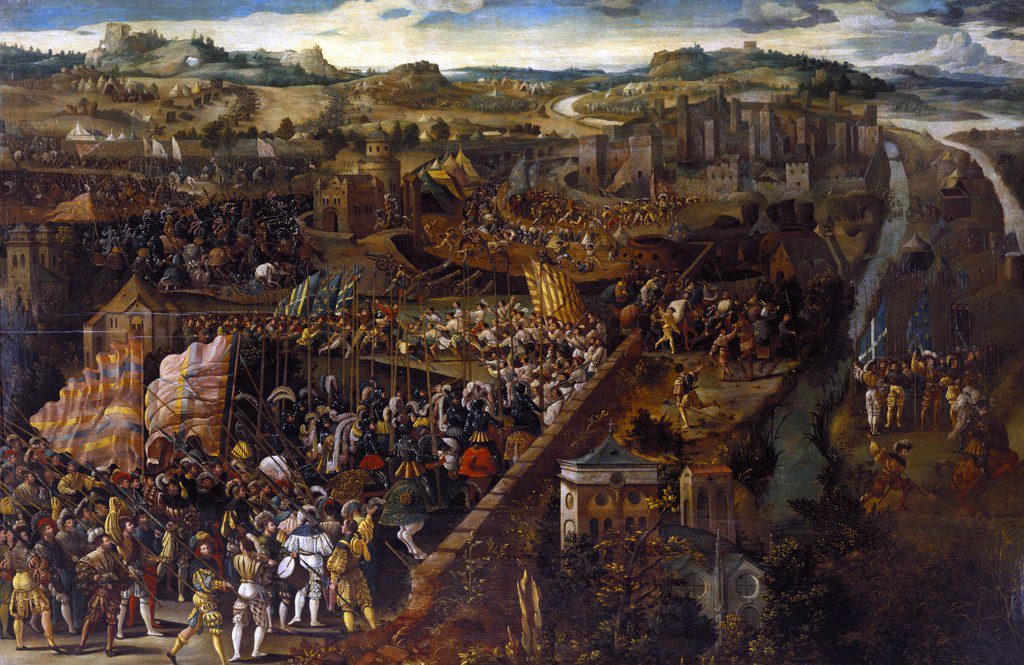On this day in history, the 18th of June 1538, the Truce of Nice was signed, ending the Italian War of 1536–38 between King François I of France and Holy Roman Emperor Charles V. 
The Italian Wars, which are often referred to as the Habsburg-Valois Wars, were a series of military conflicts between 1494 and 1559. They included the following campaigns:
- First Italian War of 1494-1498, or King Charles VIII’s War;
- Second Italian War, or King Louis XII’s War (1499–1504);
- War of the League of Cambrai (1508–1516);
- Italian War of 1521–1526, which ended with the Treaty of Madrid;
- War of the League of Cognac (1526–1530), which included the Treaty of Cambrai;
- Italian War of 1536–1538, which ended with the Truce of Nice;
- Italian War of 1542–1546 when both Charles V and Henry VIII invaded France;
- Italian War of 1551–1559, which finished with the acceptance of the Peace of Cateau-Cambrésis by Henri II of France, who renounced all his claims to Italy in this treaty.
The Valois-Habsburg Wars altered the political landscape in Italy and Europe. Italy was a center of conflicts between the Houses of Habsburg and of Valois for decades. Throughout those wars, territories were conquered and lost; numerous men from participating countries were killed; ruling dynasties were overthrown and new ones established; some Italian states were annexed and others appeared. Eventually, the Habsburgs won the battle for dominance in the region, which marked the end of Italian political independence. Yet, despite the Spanish control in centuries to come, there would still be some room for maneuver for small Italian city-states and for princes.
The Valois and the Habsburgs both had dynastic claims on Italy. The Italian War of Charles VIII was triggered by his hereditary claims to the throne of Naples, which had once been ruled by an Angevin dynasty. The Spanish monarchs possessed the hereditary claim to Naples as heirs to Alfonso V of Aragon, who had subjugated the kingdom and left it to his illegitimate son, Ferrante, in 1458. The d’Orléans and d’Angoulême, the cadet branches of the Valois royal dynasty, claimed to be the rightful heirs of the Visconti Dukes of Milan, who had died out in 1447.
As of 1498, the Duchy of Milan was an Imperial fief. When in the same year, Louis d’Orléans, grandson of Valentina Visconti, ascended the French throne, he considered his claim to Milan part of his inheritance. Valentina was also the paternal grandmother of François I, Louis’ cousin, so François viewed Milan as his rightful inheritance as well. Soon after his accession in 1515, François I continued Louis XII’s campaign against the League of Cambrai in Italy and emerged triumphant in the Battle of Marignano; according to the treaties of Noyon and Brussels signed in August 1516, the entirety of northern Italy was surrendered to France and her ally, Venice, including the Duchy of Milan.
Nevertheless, holding the Duchy of Milan was more difficult than François had initially planned. As soon as Charles von Habsburg (heir to the Spanish kingdoms as well as the lands of the Dukes of Burgundy) came to power, he reminded the world that most of northern and central Italy must be part of the Holy Roman Empire. Charles reconquered Milan from the French in 1521 and granted it to Francesco Sforza, Duke of Milan, in 1522. 
King François I, Emperor Charles V, and François’ capture at Pavia
In order to restore his holdings, François personally led his troops into Lombardy in 1525, but it all ended with his captivity at Pavia on the 24th of February 1525. Later the French monarch was imprisoned in Spain for more than a year, and then he was compelled to sign the Treaty of Madrid in January 1526, in which he gave up his claims to Italy, Flanders, and Burgundy in exchange for his release from prison. Then two French princes – Dauphin François and Henri, Duke d’Orléans – would spend several gruesome years in Spain, held as hostages by Charles.
However, not even the captivity of François’ sons destroyed his designs on Italy. Between 1530 and 1536, François was determined to recover at least some of what he had lost. He still had many supporters in Italian city-states; there were also opponents of the emperor who were dissatisfied with his rising power. Throughout his life, François firmly believed that Genoa, Milan, and Asti were all rightfully his, but recovering Milan was his main goal. He stated that half of the lands of Savoy should belong to him as heir of his mother, Louise, who had passed away in 1531.
At the beginning of 1536, King François told his council that Charles V had become too powerful in Italy, and that his archrival’s appetites for conquests must have been curbed. In February 1536, many legions of French infantry marched towards Savoy and soon occupied it. In late March, a French army (24,000 infantry and 3,000 horses) under the leadership of Philippe de Chabot, Admiral de Brion, captured Piedmont and then entered Turin in early April, but they failed to take Milan. At the same time, French partisans in Asti overthrew the Imperial viceroys.
In response, on the 25th of July 1536, the Imperial army entered Provence, taking the coast road through Nice. At the same time, Henry, Count of Nassau, commenced an invasion of Picardy from the north. François and his generals concentrated their attention on the south of their country, where Montmorency used a scorched-earth strategy in order to devastate the naturally fertile land so as not to leave any supplies for the invaders. The Provencal city of Aix fell to Charles on the 13th of August, and the emperor made his camp there with his army. As the French blocked all the routes to Marseilles, Charles could not go there to get fresh supplies for his soldiers, and thousands of his men died from disease and famine.
While the Imperial troops were blocked in Provence, the French sent reinforcements (a force of 10,000 Italian infantry and a few hundred horse) to Piedmont. More Italian troops, which served François, were raised by Guido Rangone and other military nobles from southern Lombardy. In early 1536, François and Suleiman the Magnificent established an alliance between the Ottoman Empire and France. By the end of 1536, a Turkish fleet was stationed near the coast of Genoa. However, the garrison of Genoa was reinforced, and there was no uprising of Fregoso partisans (they served François) among the local populace. François’ plans to occupy Genoa did not materialize, and soon Charles returned to Italy.
The war depleted the French treasury. François felt that negotiations with Spain were necessary, but he yearned to be in possession of as much of Piedmont as possible. Therefore, he joined his army and led his men in local skirmishes, which resulted in the occupation of the territory east of Turin to Monferrato and south to the Tanaro. In the meantime, Charles began to slowly recover control of the countryside in Piedmont, and to blockade the towns and villages held for the French.
Nevertheless, Charles V was besieged by internal and external political problems. The Turks and corsairs were becoming more active in the Mediterranean. The stability in the German lands was destroyed by religious and political troubles, and it was high time for the emperor to use a variety of means in attempt to stop the spread of Protestantism. There also was a brewing rebellion in the Netherlands. Thus, Charles was ready for a truce in Italy, just as François was.
King François I and Emperor Charles V, Truce of Nice 1538
Peace talks were opened on the border between France and Spain. However, François refused all the Imperial proposals because the crux of their differences was the Duchy of Milan. As neither François nor Charles was willing to compromise, Pope Paul III became a mediator between them. Finally, the congress did finally take place at Nice, where the two rulers reluctantly agreed on a truce of ten years, and that each would keep what he held in Italy at that moment.
The Habsburg-Valois wars were far from over. The Truce of Nice did not give the King of France what he wanted to have the most – the Duchy of Milan. Even if one of his sons could inherit the duchy, François dreamed of ruling it himself. The ruler would keep chasing his ill-fated dream, and Milan would remain a major cause of contention between Charles and him in years to come.
All images are in the public domain.
Text © 2019 Olivia Longueville







